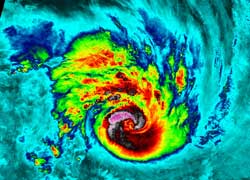NASA-NOAA's Suomi NPP Satellite Sees Powerful Cyclone Felleng

NPP IMAGE: NASA-NOAA's Suomi NPP satellite captured this false-colored night-time image of Cyclone Felleng during the night on Jan. 29, at 2109 UTC. The image clearly shows bands of thunderstorms wrapping into the eye of the storm. Felleng is west of northern Madagascar. Credit: William Straka, UWM/NASA/NOAA <br>
The Visible Infrared Imager Radiometer Suite (VIIRS) aboard NASA-NOAA's Suomi NPP satellite captured a night-time image of Cyclone Felleng when it was located east of Madagascar (4:09 p.m. EST/Jan. 30 at 12:09 a.m. local time, Madagascar).
The image was created at the University of Wisconsin-Madison and was false colored to reveal temperatures. The image shows powerful thunderstorms wrapping into the 20 nautical mile-wide (23 miles / 37 km) eye of the storm.
Felleng has intensified since Jan. 29 and as of 1500 UTC (10 a.m. EST) on Jan. 30, had maximum sustained winds near 115 knots (132.3 mph/213 kph). Felling is centered near 16.2 south and 52.6 east, about 400 nautical miles (460.3 miles/741 km) north-northwest of La Reunion Island.
Felleng is moving to the southwest at 13 knots (15 mph/24 kph) and is a threat to both Madagascar and La Reunion. The storm is creating dangerous seas, with wave heights up to 38 feet (11.5 meters).
La Reunion has already issued a Yellow Alert. For updates (in French), visit: http://www.meteo.fr/temps/domtom/La_Reunion/meteoreunion2/#
Felleng is turning towards the south and continues to intensify. The Joint Typhoon Warning Center expects Felleng to pass between La Reunion and Madagascar.
Text Credit: Rob Gutro
NASA's Goddard Space Flight Center, Greenbelt, Md.
Media Contact
All latest news from the category: Earth Sciences
Earth Sciences (also referred to as Geosciences), which deals with basic issues surrounding our planet, plays a vital role in the area of energy and raw materials supply.
Earth Sciences comprises subjects such as geology, geography, geological informatics, paleontology, mineralogy, petrography, crystallography, geophysics, geodesy, glaciology, cartography, photogrammetry, meteorology and seismology, early-warning systems, earthquake research and polar research.
Newest articles

Why getting in touch with our ‘gerbil brain’ could help machines listen better
Macquarie University researchers have debunked a 75-year-old theory about how humans determine where sounds are coming from, and it could unlock the secret to creating a next generation of more…

Attosecond core-level spectroscopy reveals real-time molecular dynamics
Chemical reactions are complex mechanisms. Many different dynamical processes are involved, affecting both the electrons and the nucleus of the present atoms. Very often the strongly coupled electron and nuclear…

Free-forming organelles help plants adapt to climate change
Scientists uncover how plants “see” shades of light, temperature. Plants’ ability to sense light and temperature, and their ability to adapt to climate change, hinges on free-forming structures in their…





















